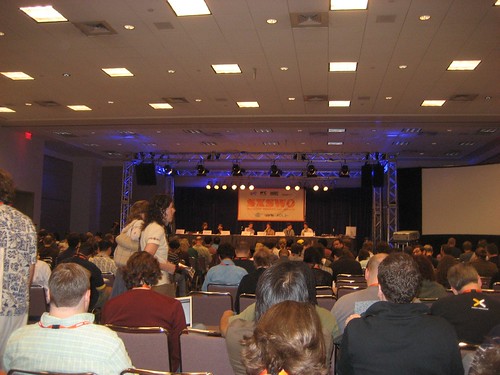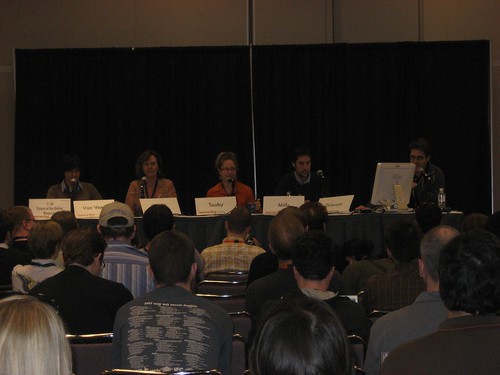Photos from SXSW

I just realized that although all my photos came through my RSS feed, I didn’t actually post a link to them from my blog.
My SXSWi 2007 Photo Set.

I just realized that although all my photos came through my RSS feed, I didn’t actually post a link to them from my blog.
My SXSWi 2007 Photo Set.
Web Typography Sucks
Mark Boulton, Owner – Mark Boulton Design
Richard Rutter, Production Dir – Clearleft Ltd
Slides located at:
http://webtypography.net/sxsw2007/
Design Patterns: Defining and Sharing Web Interface Design Languages
Luke Wroblewski, Principal Designer – Yahoo! (lukew.com)
2:00 pm – The Growth and Evolution of Microformats
Moderator: Tantek Çelik Chief Technologist, Technorati
Frances Berriman Volume
Michael Kaply IBM
Glenn Jones Creative Dir, Madgex
Tantek Çelik Chief Technologist, Technorati
Rough Panel Notes:
History of microformats through tshirts – 2003 sxsw
XFN – semantics to blogrolls to mark up
supported immediately by:
blo.gs
wordpress
2005 microformats for people, events:
eventful
done on a wiki on technorati. So made made microformats.org in 2005
microformats.org/wiki/
flickr – added microformats to profiles, and geotags
added to technorati
ode began to support for songs, playlists, etc.
2006 – event sites marked up in them
Stanford univesity – base of all their pages for contact information.
Mike – extention for firefox – operator. lets you work with microformats information.
danda.videntity.org
backnetwork – formats work for relationships, reviews, rss feeds.
glennjones.net – tear apart his site to code mine with microformats
hcard, xfn, other profiles on other sites. xfn – rel=me
creating new microformats – there’s a process managed by the community environment on micrformats.org – and people are able to present their ideas. – based on the scientific method, doing research on the web into how people are out there marking things up with classes.
Questions
———-
does it use existing semantic web efforts and ontologies – yes, they make people look at and do research on what’s existing.
Developing search engines on just formats –
kitchen.technorati.com – search for microformats, events, reviews, hcards
listings – edgeio will aggregate hcard listings – and you can ping them to get your information entered.
alexa crawls looking of hcards.
dogs that need to be adopted – dogster
Mobile – are mobile browsers finding microformatting.
jeremy keith – demo of microformats
Microformats & accessibility – a couple assesibility experts are pursuing how it can help and avoid becoming a challenge.
Restricted connet – not yet, but they asked her to get involved and develop these things.
Hcard and openID – openID 2.0 are working on all converging this –
searh for hcard creator – dreamweaver has it, so does movable type.
1:30AM The Future of the Online Magazine (19AB)
Moderator: Rufus Griscom CEO, Nerve Media
Rufus Griscom CEO, Nerve Media
Sean Mills The Onion
Ricky Van Veen Editor, CollegeHumor.com
Laurel Touby CEO & Founder, mediabistro.com
Joan Walsh Editor in Chief, Salon.com

Rough Panel Notes
collective average age of their sites – 9.5 years. Online magazines have been around for a long time – are 1.0. How have they changed given user generated content?
web 2.0 has been good for salon – is edited content obsolete? Joan – of course not. Walter Reed hospital – Salong broke story, but blogosphere really exposed it to the mainstream media.
keep in mind that newsletters still reach more people than rss feeds.
Onion started as a newspaper – try to take advantage of all of the 2.0 stuff.
There’s no replacement for talented writers and editing. Something to be said for having a full time staff to cover the dick humor even on the weekends.
media bistro – 27 staff members and 7 bloggers
salon – 28 people in editorial, 60 total
college humor – 40 people, 9 full-time editorial
onion – 13 comedy writers, 18-20 editorial
nerve – 25 people
Premium paid content – open is important because of natural link traffic. Ad revenue is increasing. Paid content is on the way out. But advertising is cyclical, so we have to think about the paid models and be nimble. Membership is a way to form a loyal core – giving stuff away, etc.
Other ways to get revenue – merchandising. – Busted tees. Books are another way – not a huge revenue generator, but enough to be worth it.
Nerve – charge only for racier photography. Insulates advertisers for racier stuff. Babble – mag for urban parents. 10 bloggers all day long, video.
Advertising is biggest revenue – 80%
media bistro – job listings classes & seminars as revenue generators.
Salon – 50,000 subscribers.
college humor – all the offline is addtional, not part of initial model. – books, movie. Shirts helped at the beginning – 1/2 of revenue.
Moderation Policies of user generated content:
college humor – require an edu address, is it more angry than it is funny
salon – very light moderation, requiring an email authenticated address to get consistent handles. Right to pull things down for any reason. Editors choice picks to bump up good letters. user moderation to rate others letters.
nerve – sometimes writers object to comments.
salon – 9/11 angry readers wrote mean things. often the community will moderate things.
does user generated content interfere with consistent voice?
college humor – built on animal house tone from users, so it’s not a problem for them. helps to have 1-3 people to serve as moderators as voice and tone of site.
onion – level of discourse on comments has been shockingly good on a.v. club, so they’ve sometimes reached out to hire commenters. no comments on onion proper – a bit different because it’s satirical.
relationship between blogs and online magazines – do people come to homepage, or from links?
salon – 75 to home page
media bistro – much of traffic to job boards, many go straight to blogs
onion – getting traffic from links is growing and is what they desire – marketing for them.
Nerve – lots of traffic is on their blogs.
whitkey – css online magazines question: why not let user content on home page?
college humor – it will if it’s good
onion – organic process for discovering new writers, so they haven’t had to. editorial model is “you are dumb”
salon – surprisingly more unsolicited stuff gets used than someone would think. They do put user-generated content on the front page if it’s really good.
Nerve – more hybrid model will come in 5 or 10 years. Combination is particularly powerful – american idol example.
larry smith – contracts for content that becomes a book or other stuff –
onion – they have content for those types of projects.
salon – they have contract for that and reward people.
nerve – we have a similar contract
media – we have standard journalist contract.
what have you done that has failed?
onion – paid subscription model didn’t work well. 24 hour news cycle; they backed off of that so much.
salon – most of cuts were based on revenue and expense.
media – haven’t had the boom in LA for classes that they had in NY.
college humor – short form video has been a big experiment and some have been good and others not.
Blogs – how do you deal with bloggers having their own sites, contracts?
media bistro – it is a problem. sometimes with a full-time bloggers. Shouldn’t be producing work on the side.
Nerve – opposite philosophy – encourage them because they generate content from their own blogs.
salon – way too busy to have their own.
Do you have your own design staffs?
onion – yes they have their own staff 3 people – better for content.
nerve – 2 full time and 3 part time – design doesn’t scale, so you need them. also, good designers is hard to find.
college humor – finding a good designer is tough. They have them.
Format question – differences between a magazine and a website, flash, pdf?
Onion – only call them magazines when talking to advertisers. otherwise call them websites.
Salon – don’t agree with the word magazine.
media bistro – trying to ptu the the magazine format online is crazy because it doesn’t take advantage of the features of the web.
Nerve – coherently branded experience is evocative of “magazines.”
Onion has print component, do others have that idea?
Nerve – didn’t work regularly. Maybe quarterly.
Onion – why do we keep it? great way to get local advertising, still works as a business.
party – club deville 6:30-8:30 open bar.
10:00AM Get Unstuck: Moving From 1.0 to 2.0
Moderator: Liz Danzico Director, experience strategy, Daylife
Liz Danzico Director, experience strategy, Daylife
Kristian Bengtsson Creative Dir, FutureLab
Chris Messina Co-founder, Citizen Agency
Luke Wroblewski Principal Designer, Yahoo!
Jeffrey Zeldman Founder, Happy Cog

Some of these overlap, so I’ll have to pick one over the other. But a rough idea.
10:00AM Get Unstuck: Moving From 1.0 to 2.0 (18ABCD)
11:30AM The Future of the Online Magazine (19AB)
02:00PM The Growth and Evolution of Microformats (18ABCD)
03:30PM Bullet Tooth Web Design: Plan Your Web Site like Pulling off a Robbery (19AB)
04:05PM Design Patterns: Defining and Sharing Web Interface Design Languages (19AB)
04:05PM The Invisible Blogosphere (8ABC)
05:00PM Do You Blog on the First Date? (10AB)
05:00PM How to Create A Kickass In-House Design Team (18ABCD)
10:00AM Web Typography Sucks (18ABCD)
11:30AM Design Aesthetic of the Indie Developer (Ballroom F)
02:00PM Will Wright Keynote Speech (Hilton / Grand Ballroom)
03:30PM How to Make Search Engine Optimization (SEO) and Usability Work Together (19AB)
03:30PM The Technologist Agenda: Political Activism for Geeks (9AB)
Oh, and while surfing YouTube looking at other’s SXSW videos, I found a video of me shot yesterday by the firefox browser people, giving testimonial on the browser from the trade show space. I got a discount on a Firefox T-shirt in exchange. Which just goes to show — I can talk your damn ear off, but if you stick a camera in my face, I have no idea what to say.
I took this video at the frog design party Saturday night of an interesting interactive design project they did.
4:05p.m. – Fictional Blogging Panel
Liz Henry, Developer Advocate – Socialtext
Odin Soli, Dir Business Dev – Aveso Inc
Rough Panel Notes:
Very interesting panel on fictional blogging as an art form, and the ethics of it. Again, my rough, not cleaned up notes because I don’t have time.
Fictional blogging: art form vs. lying/hoaxes?
it raises issues of truth, openness, secrecy
fictional blogging is not just putting a chapter of your book online. Can be:
blogging as your novels main character
role-playing – collaborative fiction
creative ecospheres
blogging memoir – lightly fictional
obvious lies – shakespeare’s blog
identity experiments
j.t. leroy
infiltration and depth
harry potter fanfic – sock puppets
lonelygirl 15
ben franklin’s prudence goodwife
Plain Layne – fictional, bisexual internet chick
– written by panel moderator Odin Soli
transgression of truth, honesty generates a huge reaction
Fiction used as Marketing
example – psp2 blog – fake teenager
publishers might want to use to promote a book as an extension
fan fiction – the science of play, mmorpgs are collaborative fiction
Ethics – violation of the social contract
Consensuality – warning people of the content before they read
authenticity violations – replacing the voices of someone who actually is that type of person
fictional characters should establish deep online presence
There is not a currently a financial market for long-form fiction online. Need more monetizational models.
Do we want to make fiction online illegal? No – we shouldn’t. But people should do it with messiness and thickness – keep it consensual, create deep worlds.
Lost and other hollywood media establishing fictional sites & creative play.
Allows people to explore ideas – what would harry potter say to genghis kahn and caroline ingalls?